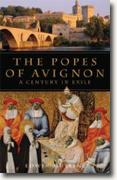The Popes of Avignon
Edwin Mullins
book reviews:
· general fiction
· chick lit/romance
· sci-fi/fantasy
· graphic novels
· nonfiction
· audio books
· author interviews
· children's books @
curledupkids.com
· DVD reviews @
curledupdvd.com
newsletter
win books
buy online
links
home
for authors
& publishers
for reviewers

 |
The Popes of Avignon: A Century in Exile Edwin Mullins Bluebridge Hardcover 256 pages September 2008 |
|
Click here to read reviewer Br. Benet Exton's take on The Popes of Avignon. Far from being a dull and boring topic, which it could have easily been transformed into by a lesser writer and historian, Edwin Mullins’ The Popes of Avignon
King Philip secured the aid of a famous French lawyer, Guillaume de Nogaret, an expert in civic and canon law. Nogaret formulated the charges against the supreme pontiff. One thing lead to another, and a mob “seized and bound the horrified Boniface.” Though he was eventually rescued, six weeks later “Boniface was dead.” King Philip definitely was aware of the usefulness of a good lawyer; as the author states, “It is no accident that all seven churchmen who were to become Avignon popes had previously been successful lawyers, or at least had received a rigorous legal training.” Though there was one other pope in Italy before the move to Avignon took place, Benedict XI, this pope realized that Rome had become a turbulent place, and “he chose to move the papal court further south, to Perugia.” Benedict XI never made it to Perugia, dying en route “having held office for less than a year.” The cardinals found themselves “in hopeless disagreement over who should be chosen as the next pope.” King Philip exerted outside pressure on the cardinals to resolve their stalemate in his favor, and the course of action the cardinals were in “general agreement” about taking was “that a successor must be sought from outside the College of Cardinals.” Through his machinations, King Philip helped to convince the cardinals that Rome wasn’t stable enough at the time and that the seat of the papacy should be moved to France. The new pope, Bertrand de Got, who chose the name Clement V, would be effectively “in the French king’s pocket.” He at times seemed to try to act on his own and did make some of his own decisions, but, he caved in to King Philip’s wishes so often that Clement V has, in general, not been thought well of by history. The other pontiffs in The Popes of Avignon For Catholics who are interested in this period of the church’s history as well as anyone else who wonders why the papacy was ever moved and wants to learn more about the reasons behind the Hundred Years War, the destruction of the Cathars, the demise of the Knights Templar, and the many other subjects the book mentions, The Popes of Avignon Originally published on Curled Up With A Good Book at www.curledup.com. © Douglas R. Cobb, 2008 |
| Also by Edwin Mullins: |
|
|
|
 Click here to learn more about this month's sponsor! |
|
| fiction · sf/f · comic books · nonfiction · audio newsletter · free book contest · buy books online review index · links · · authors & publishers reviewers |
|
| site by ELBO Computing Resources, Inc. | |
 Who could have stood up to the power of the pope of Rome? What could have made the papacy shift its local from Rome to France? It would have taken a conniving, wealthy, militarily strong and politically savvy ruler to orchestrate such a shift, and King Philip the Fair of France filled the bill. Pope Boniface had taken over as the pope after the mysterious death of Pope Celestine V, who for two years had been “immured in a castle where his successor had felt it advisable to keep him, for reasons which were never explained.” Pope Clement V and King Philip had a dispute over “certain lands in the Roman campagna which had long been claimed by both parties.” Eventually, this feud and the death of Celestine V “developed into charges of homicide.”
Who could have stood up to the power of the pope of Rome? What could have made the papacy shift its local from Rome to France? It would have taken a conniving, wealthy, militarily strong and politically savvy ruler to orchestrate such a shift, and King Philip the Fair of France filled the bill. Pope Boniface had taken over as the pope after the mysterious death of Pope Celestine V, who for two years had been “immured in a castle where his successor had felt it advisable to keep him, for reasons which were never explained.” Pope Clement V and King Philip had a dispute over “certain lands in the Roman campagna which had long been claimed by both parties.” Eventually, this feud and the death of Celestine V “developed into charges of homicide.”